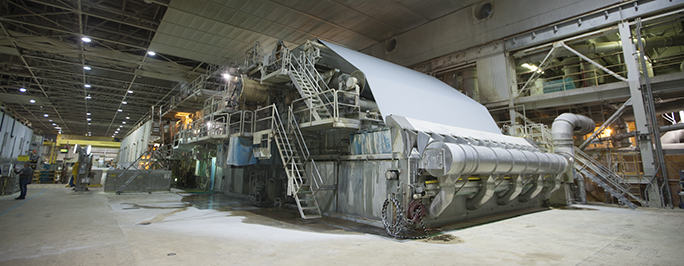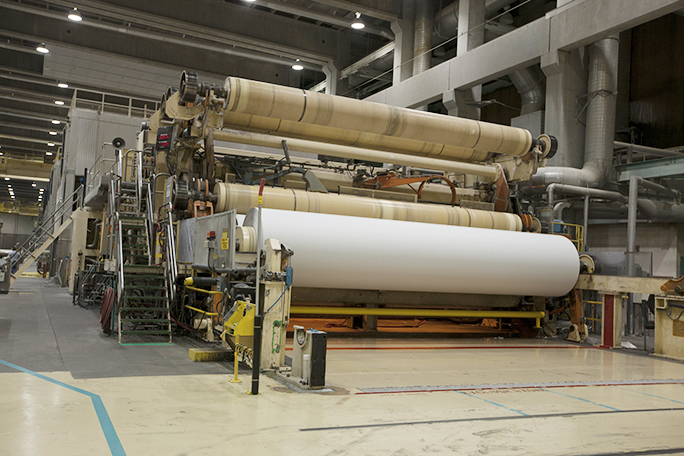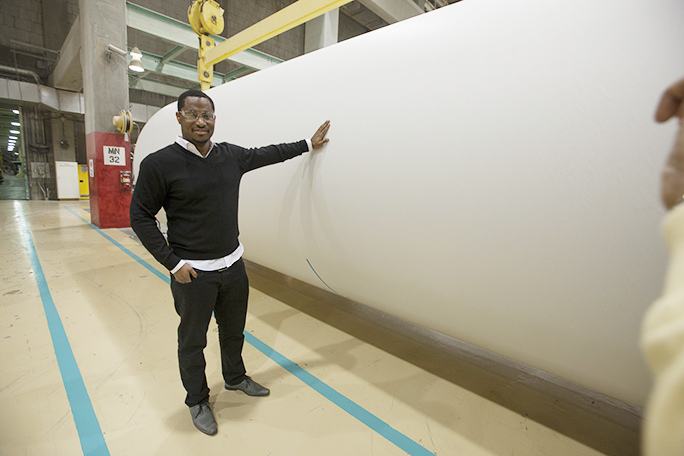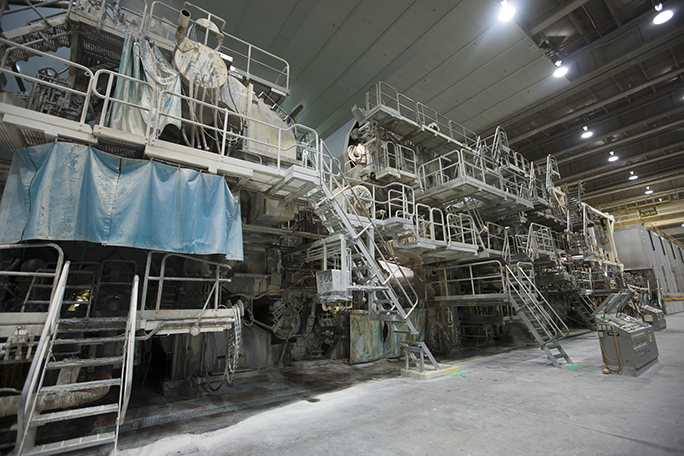Yesyerday morning a group of TAGA participants visited the Longview, Washington, paper-making plant of NORPAC. This is the largest paper-making facility in North America. Inside its massive buildings are three of the largest machines on Earth.
These machines are for making paper, and they make a lot of it. In one day, the plant produces almost 4,000 miles of paper in various grades. The primary output of the machines is newsprint for North America and Japan. The massive rolls of paper coming off the machine vary from 330 inches (27.5 feet/8.38 m.) to 350 inches (29.1 feet/8.89m.). The paper moves at about one mile per minute. After it is made, rolls of paper weighing over 28 tons are moved to re-rolling machines that move the paper at about 7,000 feet per minute as it is slit into smaller widths and rolled to finished sizes for shipping to newspapers around the world.
This is the “wet end” of Machine Two at Norpac. This 29 foot machine was making newsprint for the Wall Street Journal while we were visiting the plant. The material you see coming over the top of the machine is called the Felt; it carries the wet paper mash through the machine from the beginning to the air dried section, where other rolls of felt support the paper while it is processed further.
I asked our hosts how long their paper machines are, and they said “longer than a football field.” The machines appear to go on forever, dwarfing any humans nearby.
This is the dry end of the machine, where finished paper is wound onto rolls that weigh over 28 tons. The roll you see is about one-third of its final size, running just under one mile per minute. The paper is 27.5 feet wide on this machine.
These machines are called “double-wire” devices, meaning that they are not traditional Fourdrinier-style machines. Instead, paper pulp-and-water mash is injected vertically at the head end of the machine into the system that takes that mash up and over the top of the wet end of the machine, where it begins the long journey through the machine to the finish end. En route, the pulp is dried by hot air, then by steam-filled cylinders, then heated pressure rollers until the mash turns from mostly water to mostly fiber. I was told that water represents 99 percent of the mash at the head, and less than ten percent at the other end.
Here Yannick Abba of DowJones has his hand on a finished roll of paper weighing 28 metric tons (61,600 lbs.). The roll is about to be loaded onto a slitting and re-rolling machine to be made into smaller rolls for printing presses.
The Longview plant uses about 55 percent of the electricity in their county, power that comes from the Bonneville Dam, upstream on the Columbia River. The company that owns the plant, a 50-50 consortium of Weyerhaeuser and Nippon Paper, would buy more electricity if there were any available. Instead, the company has recently invested in a tremendously more efficient pulping plant that will save over 100 million KWh per year, making more power unnecessary.
Most of the wood pulp for paper made in Longview is Douglas Fir from Pacific coast forests in Oregon, Washington and British Columbia, Canada. A small amount of other woods are added: pine and some hardwoods. The mix is determined by the formula for paper strength. Weyerhaeuser has a corporate policy of replanting all forest land harvested with new trees within one year, and they operate one of the largest nurseries in the world to provide seedlings for this effort.
This is the wet end of Machine Three at Norpac. This is the newest of the three machines. It is about 150 yards long from this end to the dry end (beyond the right edge of this photo).
I worked in the engine room of a Coast Guard cutter when I was 18 years old. I thought that was a pretty impressive operation with its massive diesel engines, drive systems and the noise of that raw power. That whole engine room would fit into one of the control rooms in the Norpac plant; our ship’s engine room was a pip-squeak operation compared to the block-long paper making machines I saw today.
The output of these machines yesterday was newsprint, though the company also makes other grades of paper for book and publication printing. The finished rolls typically weigh a half-ton or more. Wrapped in kraft paper and capped with a heavy protective side panel of kraft, these rolls are treated with amazing care. A ding, a dent or a crush of the center hub could cause the roll to be unusable. Automated conveyors move the finished rolls from the re-rolling machine to the wrapping stations, then the finished rolls are gently moved into a huge warehouse for shipment by ship to Asia, or by truck or train to west coast newspapers.
Cal Poly’s supply of newsprint probably comes from this mill, though I don’t know for sure. We use only a few rolls a week; the giant operations of the Wall Street Journal, USA Today, the Los Angeles Times and other newspapers consume most of the output from this plant.
As I sat in the Portland airport, waiting to board a plane back home, I saw a man reading the day’s Wall Street Journal. I was thinking, “I know where that paper came from!” I’ll bet the man reading it has no idea that the mill that makes the paper is just miles from here, along the Columbia River north of Portland.





